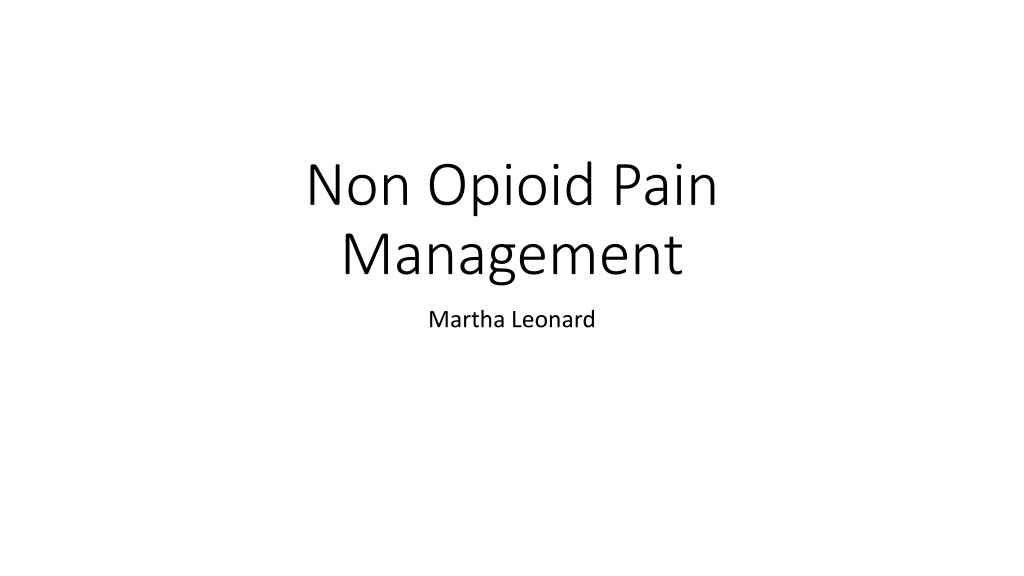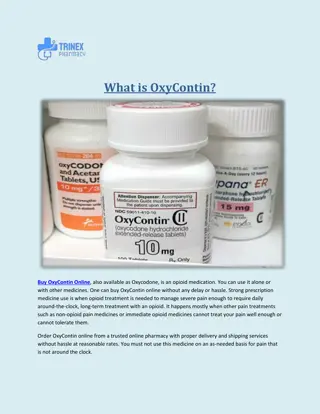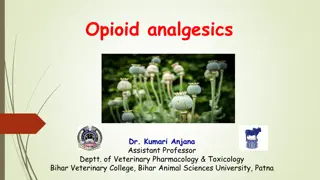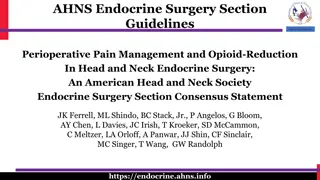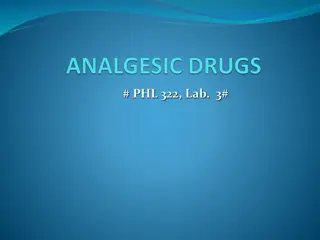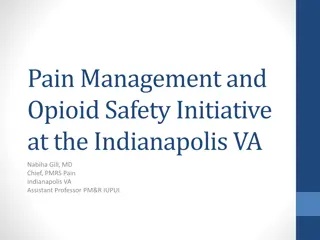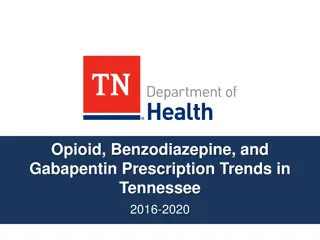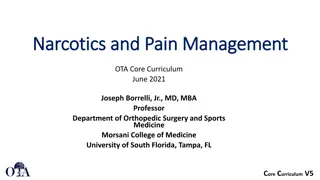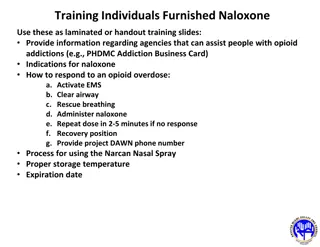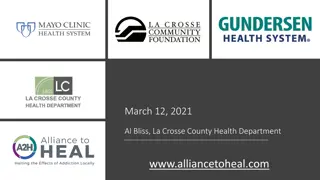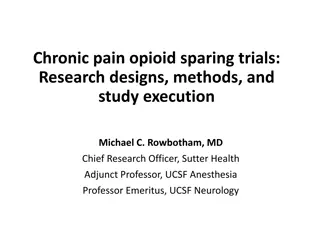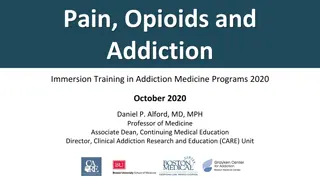Understanding Non-Opioid Pain Management Strategies
Non-opioid pain management is crucial in the current opioid epidemic, requiring physicians to navigate chronic pain without relying on opioids. This comprehensive approach involves a deep understanding of non-opioid analgesic medications, the nature of pain, anatomy, and physiology of nociception, types of pain, the four-step analgesic ladder, and non-opioid analgesic management. Key components include NSAIDs, corticosteroids, and interventional pain modalities like acupuncture and physical therapy. By recognizing different pain types and utilizing appropriate therapies, healthcare providers can effectively address patients' pain needs.
- Pain management
- Non-opioid analgesics
- Chronic pain
- Interventional therapies
- Non-pharmacological interventions
Download Presentation

Please find below an Image/Link to download the presentation.
The content on the website is provided AS IS for your information and personal use only. It may not be sold, licensed, or shared on other websites without obtaining consent from the author. Download presentation by click this link. If you encounter any issues during the download, it is possible that the publisher has removed the file from their server.
E N D
Presentation Transcript
Non Opioid Pain Management Martha Leonard
Opioid Epidemic Physicians are now in a catch 22- needing to manage chronic pain in patients previously treated with opioids, but now encouraged to NOT use opioids. This will require an approach with a strong knowledge base in non opioid analgesic medications.
Nature of Pain Nature of Pain Unpleasant sensory and emotional experience Subjective Palliative care providers consider pain as total pain Physical Total Pain Spiritual Mental Emotional
Anatomy and Physiology of Nociception and Analgesia Activation by mechanical, thermal, and chemical injury Nerve fibers classified as A, B, and C fibers with alpha, beta, delta, and gamma subcategories A Delta fibers respond to pricking, squeezing, and pinching and lead to the fast, sharp pain Polymodal C fibers respond to many noxious stimuli and produce slow, throbbing, and more diffuse pain Descending inhibitory neural pathways from the brain to the spinal cord involve serotonin and norepinephrine
Types of Pain Acute versus Chronic Nociceptive versus Neuropathic Somatic versus Visceral Cancer versus Non-Cancer Knowing the type of pain, the location, and severity will guide the therapy needed.
Four Step Analgesic Ladder Interventional Anesthetic pain therapies Strong Opioid, adjuvant analgesic,non Moderate opioid, adjuvant analgesic, non opioid opioid Non opioid, adjuvant analgesics
Non Opioid Analgesic Management NSAIDS Acetylsalicylic acid (ASA) Paracetamol (acetaminophen) Corticosteroids Adjuvant analgesics or what is now called co-analgesics Interventional pain modalities Including acupuncture, TENs unit, counseling, PT/OT, and other non- pharmacological interventions
NSAIDS indications Inflammatory pain (pleuritic chest pain, pericarditis) Pain due to bony metastases Soft tissue injuries, dysmenorrhea, dental pain, Headache Musculoskeletal pain
NSAIDS mechanism and types NSAIDs inhibit Work by inhibiting the enzyme cyclooxygenase (COX) and that prevents the production of prostaglandins COX-2 COX-1 Inducible @ sites of inflammation Constitutive Two types of COX, constitutive (COX-1) and inducible form (COX-2)
NSAIDS Non selective Cox-1 + Cox 2 Ibuprofen Naproxen Diclofenac Indomethacin Meloxicam Selective Cox -2 Celecoxib Valdecoxib Etoricoxib
Which Route for NSAIDs Oral-most common IV useful in hospital settings (ketorolac) Topical (diclofenac or Voltaren gel)
Side Effects/Complications/Contraindications of NSAIDS Where What Pain, Nausea, Gastric erosion and ulceration, GI bleedings, perforation (up to 20% of patients will develop this side effect) Celebrex best, followed by Naproxen and ibuprofen GI tract Water and sodium retention, edema, hyperkalemia, decreased efficacy of antihypertensive medications and diuretics (sulindac considered more safe) Kidney HA, confusion, vertigo, depression, dizziness CNS Inhibition of activation, increased risk of bleeding (Risk continues for 2 days after discontinuation of NSAIDS and 7 days after ASA discontinued) Platelets Rhinitis, Bronchial Asthma, Urticaria, Flushing, Hypotension, Shock and hepatoxicity Other- Hypersensitivity
Cardiovascular toxicity of NSAIDS Naproxen thought to have less risk for this Absolute risk is small (2 events per 1000 persons per year in patients with low risk and 7 to 8 per 1000 persons per year , including 2 fatal events in persons with high risk) Risk worse when NSAIDs thought to impact blood pressure as well as pro-thrombotic effects
GI toxicity Guidelines for risk stratification History of ulcer or GI hemorrhage Age>60 (increased risk 5 to 6 times) High dose of the NSAID, which increases risk 10 fold Concurrent use of glucocorticoids Concurrent use of anticoagulants High Risk: history of previous complicated ulcer or 2 or more of risks (rec not using) Moderate Risk: 1 or 2 risk factors Rec using low dose and with PPI Low Risk: no risk factors, okay to use without PPI
NSAIDs take home points Useful for bone pain and inflammation, not as useful for neuropathic pain Relative contraindication in patients at high risk for peptic ulcer disease (advanced age, history of PUD or prior NSAID gastroduodenopathy, advanced illness, concurrent corticosteroids use) Relative contraindication in patients with CV disease or hypercoagulability Contraindicated in renal disease, multiple myeloma, or low perfusion states Naproxen thought to be less likely to increase risk of CV events Celebrex, then ibuprofen or naproxen less likely to cause GI toxicity Potency of maximum doses of NSAIDs equivalent to 5 to 10mg IV morphine in studies
Cases for NSAIDs-why or why not 60 yo female with ovarian cancer and bowel obstruction w/ history of PUD 55 yo male with ischemic cardiomyopathy with comorbid gout and osteoarthritis presents w/ knee pain 64 yo male with newly diagnosed glioblastoma multiforme currently on corticosteroids 67 yo female with metastatic breast cancer with bone metastasis and brain metastasis w/ comorbid CKD 55 yo male with PMHx of PUD presenting with newly diagnosed prostate cancer with bone metastasis
Acetaminophen Acetaminophen Analgesic and antipyretic, not considered an anti- inflammatory Mechanism is poorly understood Used in various combination products Preferred over NSAIDs for pediatric and elderly patients
Acetaminophen Acetaminophen Hepatotoxicity is greatest concern with Acetaminophen Suggested maximal dose of 650mg and maximal total dose of 3 grams or less in a 24 hour period No more than 325mg in combination opioid/APAP drugs
Cases for Tylenol-why or why not 60 yo female with ovarian cancer and bowel obstruction with escalating pain requiring more frequent Lortab for pain 55 yo male with ischemic cardiomyopathy with comorbid gout and osteoarthritis 64 yo male with newly diagnosed glioblastoma multiforme with comorbid cirrhosis 67 yo female with metastatic breast cancer with bone metastasis and brain metastasis with current etoh abuse disorder 55 yo male with PMHx of PUD presenting with newly diagnosed prostate cancer with bone metastasis
Adjuvant Analgesics Adjuvant Analgesics A drug that has a primary indication other than pain, but is analgesic in some painful conditions Sometimes called co-analgesic
Adjuvant Analgesics/ Co-analgesics Multipurpose Neuropathic pain Topical Bone Pain Bowel obstruction Musculo- skeletal/Misc Antidepressants Anticonvulsants Capsaicin Calcitonin Octreotide Muscle relaxants Corticosteroids Sodium Channel Blockers Local anesthetics Bisphosphonate Anticholinergics Psychostimulant Alpha-2 adrenergic agonists N-Methyl-D Aspartate Receptor blockers NSAIDS Radio- pharmaceuticals Corticosteroids Neuroleptics Cannabinoids NSAIDs and corticosteroids Misc. (baclofen, calcitonin)
Analgesic Antidepressants Used primarily for neuropathic pain, sometimes in chronic pain Mechanism based on enhanced availability of monoamines at synapses within the descending inhibiting pain modulating nervous system Best established with SNRIs and TCAs (bupropion and SSRI used less) Preferred SNRI is duloxetine, preferred TCA is nortriptyline or despiramine Benefit of bupropion has been suggested in some studies and is more activating (but contraindicated with history of seizures) First line without depression gabapentin or pregabalin First line with depression SNRIs or tricylics
Corticosteroids Multipurpose medication-nausea, pain, anorexia, malaise/fatigue, pain Pain uses related to neuropathic pain, bone pain, pain associated with capsular expansion or duct obstruction, bowel obstruction, or lymphedema, and HA associated with ICP Decadron preferred due to longer half life (daily dosing possible) and relatively low mineralocorticoid effects Decadron 1 to 2mg Po or IV BID starting (sometimes after loading dose of 10mg) unless using for ICP or bowel obstruction Long term risk with myopathy, immunocompromise, steroid induced diabetes, osteoporosis, and hypoadrenalism
Alpha-2 adrenergic agonists Clonidine and tizanidine used Clonidine can be given orally, transdermally, or intraspinally Spinally administered more for neuropathic than nociceptive Side effects dry mouth, hypotension (orthostatic), and somnulence
Anticonvulsants Anticonvulsants Gabapentin and pregabalin act by binding to the alpha-2 delta protein modulator of the N type, gated calcium channel which then reduces calcium influx into the neuron, and lessens the likelihood of depolarization No drug-drug interactions, not metabolized by the liver (unlike other anticonvulsants) Gabapentin has a pharmacokinetic ceiling (usually 1800mg per day), pregabalin does not
Dosing of anticonvulsants Gabapentin Pregabalin Start at 50mg to 75 mg daily in two divided doses and titrate to 150 to 300mg twice daily over 1 week Start with 100 to 300mg daily and increase dose gradually every few days to max dosing of 3600mg per day
Bone Pain Bisphosphonates Calcitonin Denosumab Bone Targeted Radioisotopes Corticosteroids and NSAIDS Lack of evidence based literature for use of corticosteroids in pain Inhibit osteoclast activity, stimulate osteoblasts to produce osteoclast inhibiting factor, and causing osteoclast apoptosis Renal function warnings Temporary flu like syndrome Hypocalcemia (VIT D deficient) Osteonecrosis of the jaw Typical dosing of zometa: 4mg IV Ibandronate has oral and IV forms Inhibits osteoclast activity by targeting receptor activator of nuclear factor Kappa B ligand (RANKL) Compared to zoledronic acid Same side effects as bisphosphonates One advantage over zometa is quick infusion and lack of renal function impairment Examples include strontium-89 and samarium-153 Provides a short lived radiation source to bisphosphonate molecule Usually limited in use as causes myelosupression (12 weeks after) Can cause a transitory pain flare immediately after (5 to 10% of patients) Conflicting evidence of efficacy
Cannabinoids Cannabinoids Derived from the cannabis plant, which contains over 400 compounds, including more than 60 cannabinoids. Primary psychoactive cannabinoid is delta-9-tetrahydrocannabinol (THC, also known as dronabinol) Mechanism is related to endogenous system that includes cannabinoid-like ligands (endocannabinoids) as well as multiple receptors in the CNS and periphery Sativex =nabiximols (approved in Canada) is an oromucosal spray which includes THC and cannabidol, approved for neuropathic pain in MS and cancer Nabilone is started at 0.5mg to 1mg qhs and titrated up to 3mg BID THC (Dronabinol) is started at 2.5mg daily or twice daily Side Effects: dizziness, somnulence, and dry mouth
Ketamine, NMDA receptor antagonist Ketamine, NMDA receptor antagonist N-methyl-D-aspartate receptor antagonist, Ketamine involved in the CNS (sensitization of the central neurons and the functioning of the opioid receptor and possible analgesic properties) Used primarily in refractory pain (neuropathic suspected) at end of life Extensive list of side effects, including delirium/hallucination and as such usually given with benzodiazepine or neuroleptic Dose- 0.05 to 0.4mg/kg/h infusion after initial 0.1 to 0.5mg/kg bolus dose or IV burst doses 0.25 to 0.5mg/kg or oral doses 0.3 to 0.5mg/kg tid
Topical Agents Lidocaine patch or gel Capsaicin EMLA NSAIDs/other Constituent of chili pepper Depletes substance P form afferent C fibers Available as cream or patch Used for focal areas of neuropathy or arthropathy Must use for several weeks/4 times a day Lidocaine 5% patch Can use q 24 hours Patches expensive, may be less expensive to use gel Can cut patches and can apply up to 3 or 4 Eutectic mixture of local anesthetics (1:1 mix of prilocaine and lignocaine Used to prevent pain at incision or puncture sites Short lived anesthetic that is expensive Diclofenac patch 1.3% or 1% gel available Patch is applied BID Gel dose is 2 to 4 gm qid for 7 days Other- cream with tricylic (amitriptyline 2% with or without ketamine1%) for neuropathic pain with conflicting evidence Topical doxepin for pruritis
Bowel Obstruction Analgesics Corticosteroids Octreotide Anticholinergics Various dosing regimens have been recommended, tend to use decadron 4mg q6 or q 8hour Risk of perforation concerning Mechanism unknown, suspected to decrease edema surrounding tumors and obstruction Mechanism is the inhibition of secretion of gastric, pancreatic, and intestinal secretions and reduced GI motility Usually dose 50 to 100mcg subcutaneously TID for short course (usually 3 to 5 days) Scopolamine and Glycopyrrolate used primarily Decreases secretions and decreases GI motility as well
Acupuncture and TENS TENS Historically used, dating back to 2500 BC Mechanism thought to be due to the gate theory , selective electrical stimulation of the certain nerves block the pain impulses to the brain Acupuncture Very old procedure for pain management In category with cupping, scarification, cauterization Acupuncture releases multiple endogenous substances (Beta- endorphin, metenkephalin, and dynorphins which activate opioid receptors; releases serotonin and oxytocin, endogenous steroids. It also up regulates opioid gene production
Generals 60 yo female with ovarian cancer and bowel obstruction 55 yo male with ischemic cardiomyopathy with comorbid gout and osteoarthritis 64 yo male with newly diagnosed glioblastoma multiforme 67 yo female with metastatic breast cancer with bone metastasis and brain metastasis 55 yo male with PMHx of PUD presenting with newly diagnosed prostate cancer with bone metastasis
References 1. Section 10.1 The Management of Pain. IN: Hanks GW, Cherny N, Christakis NA, Fallon M, Stein K, Portenoy RK, eds. Oxford Textbook of Palliative Medicine, 4th edition. Oxford: Oxford University Press, 2010. Part 8 Pain. IN: Bruera E, Higginson IJ, Ripamonti C, von Gunten C, eds. Textbook of Palliative Medicine. London: Edward Arnold Publishers Ltd, 2006. Chapter 8 The Principles of Pain Management. IN: Faull C, Yvonne C, Daniels L, eds. Handbook of Palliative Care, 2ndedition. Oxford: Blackwell Publishing Ltd, 2005. Up to Date Topic: Cancer Pain management: Use of Acetaminophen and Nonsteroidal anti-inflammatory drugs. Portenoy RK, Ahmd E, Keilson YY Authors. Abrahm J, Savarese D, eds. Up to Date Topic: NSAIDS: Therapeutic Use and Variability of Response in Adults. Solomon D, Author. Furst DE, Romain PL, eds. 2. 3. 4. 5.
